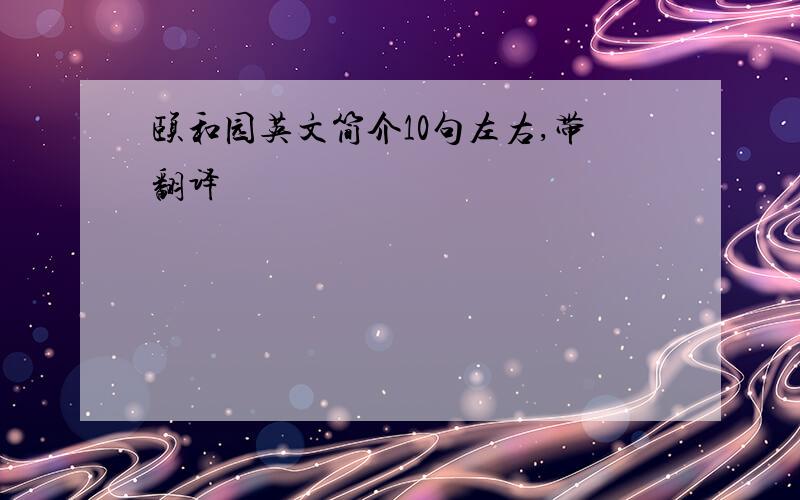颐和园英文简介10句左右,带翻译
来源:学生作业帮助网 编辑:作业帮 时间:2024/11/17 09:28:32

颐和园英文简介10句左右,带翻译
颐和园英文简介
10句左右,带翻译
颐和园英文简介10句左右,带翻译
Situated in the western outskirts of haidian district, the summer palace is 15 kilometers (9.3 miles) from central beijing. having the largest royal park and being well preserved, it was designated, in 1960 by the state council, as a key cultural relics protection site of china. containing examples of the ancient arts, it also has graceful landscapes and magnificent constructions. the summer palace is the archetypal chinese garden, and is ranked amongst the most noted and classical gardens of the world. in 1998, it was listed as one of the world heritage sites by unesco.
Constructed in the jin dynasty (1115-1234), during the succeeding reign of feudal emperors; it was extended continuously. by the time of the qing dynasty (1644-1911), it had become a luxurious royal garden providing royal families with rest and entertainment. originally called "qingyi garden" (garden of clear ripples), it was know as one of the famous "three hills and five gardens" (longevity hill, jade spring mountain, and fragrant hill; garden of clear ripples, garden of everlasting spring, garden of perfection and brightness, garden of tranquility and brightness, and garden of tranquility and pleasure). like most of the gardens of beijing, it could not elude the rampages of the anglo-french allied force and was destroyed by fire. in 1888, empress dowager cixi embezzled navy funds to reconstruct it for her own benefit, changing its name to summer palace (yiheyuan). she spent most of her later years there, dealing with state affairs and entertaining. in 1900, it suffered again, being ransacked by the eight-power allied force. after the success of the 1911 revolution, it was opened to the public.
颐和园是我国现存规模最宏大、最完好、的古代园林.位於北京市海淀区境内,距天安门20馀公里,占地290公顷.
颐和园原为封建帝王的行宫和花园,远在金贞元元年 (1153年)即在这里修建『西山八院』之一的『金山行宫』.明弘治七年(1494年)修建了园静寺,后皇室在此建成好山园.1664年清廷定都北京后,又将好山园更名为『瓮山行宫』.清乾隆年间,经由15年的修建工程,将该园改名为『清漪圆』.此时的清漪园,北自文昌阁至西宫门筑有围墙,东、南、西叁面以昆明湖水为屏障,园内修建了狠多亭台楼阁,桥廊斋榭,山净水秀,富丽堂皇.咸丰十年(1860年),英法联军疯狂抢劫并焚烧了园内大部门建筑,除宝云阁(俗称『铜亭』)聪明海、多宝 琉璃塔幸存外,至宝被洗劫一空,建筑夷为一片废墟.光绪十四年(1888年)慈待太后挪用海军经费3000万两白银,在清漪园的废墟上兴建起颐和园.光绪二十六年(1900年)颐和园又遭八国联军的野蛮破坏,后慈禧又动用巨款重新修复.数百年来,这里一直是封建帝王、皇室的享乐之地,解放辟为公园.1961年国务院宣布颐和园为全国重点文物保护单位.
Composed mainly of longevity hill and kunming lake, the summer palace occupies an area of 294 hectares (726.5 acres), three quarters of which is water. guided by nature, artists designed the gardens exquisitely so that visitors would see marvelous views and be amazed by perfect examples of refined craftwork using the finest materials.
Centered on the tower of buddhist incense (foxiangge) the summer palace consists of over 3,000 structures including pavilions, towers, bridges, and corridors. the summer palace can be divided into four parts: the court area, front-hill area, front-lake area, and rear-hill and back-lake area.
Front-hill area: this area is the most magnificent area in the summer palace with the most constructions. its layout is quite distinctive because of the central axis from the yard of kunming lake to the hilltop, on which important buildings are positioned including gate of dispelling clouds, hall of dispelling clouds, hall of moral glory, tower of buddhist incense, the hall of the sea of wisdom, etc.
Rear-hill and back-lake area: although the constructions are fewer here, it has a unique landscape, with dense green trees, and winding paths. visitors can feel a rare tranquility, and elegance. this area includes scenic spots such as garden of harmonious interest and suzhou market street.
Court area: this is where empress dowager cixi and emperor guangxu met officials, conducted state affairs and rested. entering the east palace gate, visitors may see the main palace buildings: the hall of benevolence and longevity served as the office of the emperor, the hall of jade ripples where guangxu lived, the hall of joyful longevity, cixi‘s residence, the hall of virtue and harmony where cixi was entertained.
Front lake area: covering a larger part of the summer palace, opens up the vista of the lake. a breeze fluttering, waves gleam and willows kiss the ripples of the vast water. in this comfortable area there are the eastern and western banks, the seventeen-arch bridge, nanhu island, and so on. on the western bank float six distinct bridges amongst which the jade-belt bridge is the most beautiful.
颐和园包括万寿山、昆明湖两大部门,园内山水秀美,建筑雄伟.全园有各式建筑3000馀间,园内布局可分为政治、糊口、游览叁个区域.政治流动区,以仁寿段为中央,是过去慈禧太后和光绪天子办理朝事、会见朝臣、使节的地方.糊口栖身区,以玉澜堂、宜芸馆、乐寿堂为主体,是慈禧、光绪及后妃栖身之地.风景游览区,以万寿山前山、后山、后湖、昆明湖为主, 是全园的主要组成部门.
在世界古典园林中享有盛誉的颐和园,布局和谐,浑然一体.在高60米的万寿山前山的中心,纵向自低而高排列着排 云门、排云股、德辉殿、佛香阁、聪明海等一组建筑,依山而立, 步步高升,气派雄伟.以高大的佛香阁为主体,形成了全园的中央线.沿昆明湖北岸横向而建的长廊,长728米,共273间, 像一条彩带横跨於万寿山前,连结着东眼前山建筑群.长廊中有精美柁画 14000多幅,素有『画廊』之美称.位於颐和园东北角,万寿山东麓的谐趣园,具有浓重的江南园林特色,被誉为 『园中之园』.
占全园总面积四分之叁的昆明湖,湖水清澈碧绿,景色宜人.在广阔的湖面上,有叁个小岛点缀,其主要景物是西堤、西堤六桥、东堤、南湖岛、十七孔桥等.湖岸建有廓如亭、知春亭、凤凰墩等秀美建筑,其中位於湖西北岸的清晏舫(石访)中西合璧,精巧华丽,是园中闻名的水上建筑.后山后湖,林茂竹青,景色幽雅,到处是松林曲径,小桥流水,风格与前山迥然不同.山脚下的姑苏河,曲折蜿蜒,时狭时阔,颇具江南特色.在岸边的树丛中建有多宝琉璃塔.后山还有一座仿西藏建筑——香岩宗印之阁,造型奇异.姑苏街原为宫内的民间买卖街,现已修复并向游人开放.拥山抱水,绚丽多姿的颐和园,体现了我国造园艺术的高超水平.